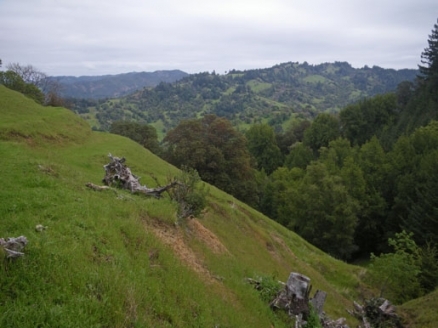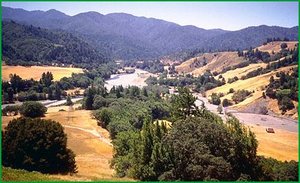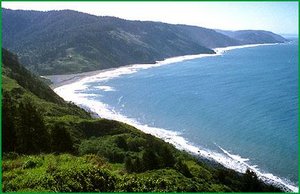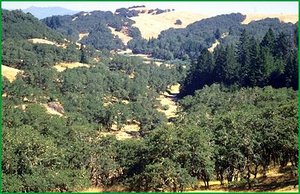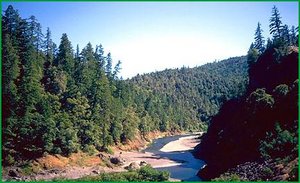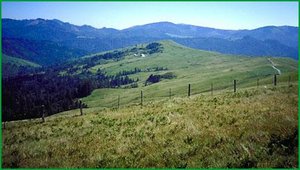Coastal Franciscan
Contents
Coastal Franciscan
The Coastal Franciscan subsection is a steep mountainous area of the Northern California Coast Ranges, near the coastal zone, south from Humboldt Bay to the Russian River. There is substantial oceanic influence on climate, including summer fog. This treatment of subsection MLRA 4b follows that of Bailey.
Lithology and Stratigraphy
This subsection is dominated by Cretaceous, Jurassic, and early Tertiary Franciscan marine sedimentary rocks of mostly the Coastal Belt, but includes some of the Central and Eastern Belts. There are relatively small areas of upper Pliocene marine sediments at the north and south ends of the subsection and Tertiary marine sediments in and around the Kings Range. Ultramafic rocks are scattered through the Franciscan Complex.
Geomorphology
This is a subsection of mountains with rounded ridges, steep and moderately steep sides, and narrow canyons. Most of the mountains are elongated in north-northwest to northwest directions and have subequal summits. There are small areas of Quaternary alluvium along the Van Duzen, Eel, Navarro, and Russian Rivers. The subsection elevation range is from sea-level up to 4088 feet at Kings Peak. Mass wasting and fluvial erosion are the main geomorphic processes.
Soils
The soils are mostly Ultic and Mollic Hapudalfs in the northern part, Ultic Haplustalfs in the southern part, and Ultic and Typic Haploxeralfs in the central and southern interior parts of the subsection. They are predominantly Typic Tropohumults and Ultic Hapludalfs on Tertiary marine sediments east of the King Range. The soils are leached free of carbonates, and some older soils are strongly acid. The soil temperature regimes are predominantly isomesic, but are mesic in the central and southern interior parts of the subsection. Soil moisture regimes are predominantly udic in the northern part, ustic in the southern part, and xeric (nearly udic or ustic) in the central interior part of the subsection.
Vegetation
The predominant natural plant communities are Redwood series, Douglas-fir - tanoak series, and Needlegrass grasslands in the King Range, and Douglas-fir - tanoak series in the central and southern interior parts of the subsection. Canyon live oak series is common on very steep slopes. Sergeant cypress series is common on serpentinitic soils. Black cottonwood series is common in riparian areas.
Characteristic series by lifeform include:
- Grasslands: California annual grassland series, European beachgrass series, Foothill needlegrass series, Introduced perennial grassland series, Purple needlegrass series.
- Shrublands: Coyote brush series.
- Forests and woodlands: Black cottonwood series, Black oak series, Blue oak series, California bay series, Canyon live oak series, Coast live oak series, Douglas-fir—tanoak series, Grand fir series, Interior live oak series, Oregon white oak series, Ponderosa pine series, Redwood series, Sergeant cypress series, Sitka spruce series, Tanoak series, Valley oak series.
Climate
The mean annual precipitation is about 40 to 110 inches. Most is rain at lower elevations and some is snow at higher elevations. Mean annual temperature is about 40° to 53°F. The mean freeze-free period is about 225 to 300 days.
Surface Water
Surface runoff (Surface runoff) is typically rapid, and many of the smaller streams are dry by the end of the summer. Natural lakes of any significant size are absent.
Return to Northern California Coast
